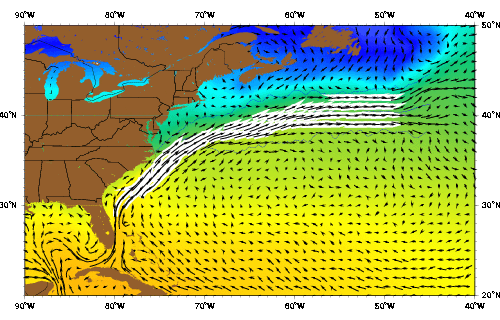
Typically, the meeting of these two currents combines a warm flow from the south and oxygen-rich water from the north, producing an environment that can support a rich diversity of marine species along the stretch of continental shelf known as the Grand Banks. But at the end of the last decade warming ocean waters caused the Gulf Stream to migrate north, in turn displacing the Labrador Current so that it meets its southern dance partner further offshore, toward the eastern limits of the giant underwater plateau.
The Gulf Stream is a part of the North Atlantic Current, itself part of a larger system collectively called the Atlantic meridional overturning circulation (AMOC). The AMOC follows a course that zig-zags northward, running from the west coast of Africa across to the Caribbean, and then tracking northeast towards northern Europe. Under normal circumstances, the warm water from this southern stream cools when it meets the currents flowing south from the Arctic; this causes the water to sink into the depths where it joins another current that runs south, deep under the Atlantic, to continue its journey through the world’s oceans.
However, the accelerated melt of glaciers in Greenland has caused a large amount of fresh water to flood into the ocean where this downward convection takes place, and this fresh water, being less dense than salt water, inhibits the sinking of the current’s waters, effectively producing a bottleneck that slows the entire AMOC. This disruption has caused the slowdown of the entire system in the North Atlantic, in turn causing a backlog of warm water from the Caribbean to build up off of the east coast, prompting the Gulf Stream’s northward migration, and in turn pushing the Labrador Current further out to sea.
“We used satellite data to show that when the Gulf Stream migrates closer to the underwater plateau known as the Grand Banks of Newfoundland, as it did after 2008, it blocks the southwestward transport of the Labrador Current that would otherwise provide cold, fresh, oxygen-rich water to the North American shelf,” according to the study’s lead author, Goncalves Neto.
This shift seen in 2008 was the beginning of a series of warm temperature anomalies that persisted over the course of the next decade, particularly in the Laurentian Channel, the body of water between Canada’s provinces of Newfoundland and Nova Scotia. And as with all things, these warming anomalies had a cascading effect on other neighboring climates.
“This mechanism explains why the most recent decade has been the hottest on record at the edge of the Northeast United States and Canada, as the delivery system of cold water to the region got choked off by the presence of the Gulf Stream,” Neto explained.
“When the Gulf Stream blocks the Labrador Current, temperatures rise and oxygen concentrations plunge along much of the eastern North American shelf,” added co-author Joe Langan. “These changes can directly impact temperature-sensitive fish and invertebrate species: warm-tolerant species from the south may establish themselves in Atlantic Canada, cold-loving species may move further northward and offshore.”
Subscribers, to watch the subscriber version of the video, first log in then click on Dreamland Subscriber-Only Video Podcast link.
MOTK coming true…
MOTK indeed. Got to dig that out time to see what’s coming next…
We’re not going to make it. Most of us, anyway. That’s my sense.
As outlined in The Coming Global Superstorm…
“We’re not going to make it?” My take is that life is a gift, every day. Currently, I spend part of each day on social media (including UC), giving pandemic feedback to people ranging from US Federal officials to US writers and others. It’s been interesting. Regarding the recent press announcement from an Indian airline company, included on a recent CNN news summary online, indicating that the airline planned to increase its daily flights to the US starting the following week, I replied to US Transportation Secretary Pete Buttigeig, “Are you crazy?” (Followed by an explanation of why increased flights from India would *not* be a good idea for the US in the midst of a profound pandemic spike in India.) 24 hours later, the White House Press Secretary announced that US air travel from India would be cut back sharply in 4 days. I’m not saying that policy change was caused by me, but at least it didn’t hurt to try.